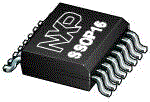- No Longer Manufactured
- NE1617ADS
Temperature monitor for microprocessor systems
- This page contains information on a product that is no longer manufactured (discontinued). Specifications and information herein are available for historical reference only.
The NE1617A is an accurate two-channel temperature monitor. It measures the temperature of itself and the temperature of a remote sensor. The remote sensor is a diode-connected transistor. This can be in the form of either a discrete NPN/PNP, such as the 2N3904/2N3906, or a diode-connected PNP built into another die, such as is done on some Intel microprocessors.
The temperature of both the remote and local sensors is stored in a register that can be read via a 2-wire SMBus. The temperatures are updated at a rate that is programmable via the SMBus (the average supply current is dependent upon the update rate — the faster the rate, the higher the current).
In addition to the normal operation, which is to update the temperature at the programmed rate, there is a one-shot mode that will force a temperature update.
There is also an alarm that senses either an overtemperature or under temperature condition. The trip points for this alarm are also programmable.
The device can have one of nine addresses (determined by two address pins), so there can be up to nine of the NE1617A on the SMBus.
It can also be put in standby mode (in order to save power). This can be done either with software (over the SMBus) or with hardware (using the STBY pin).
Product Details
Part numbers include: NE1617ADS.
Documentation
Quick reference to our documentation types.
1-5 of 8 documents
-
Application Note
Digital temperature sensor accuracy explained
-
Application Note
AN10216
-
User Guide
I2C-bus specification and user manual

